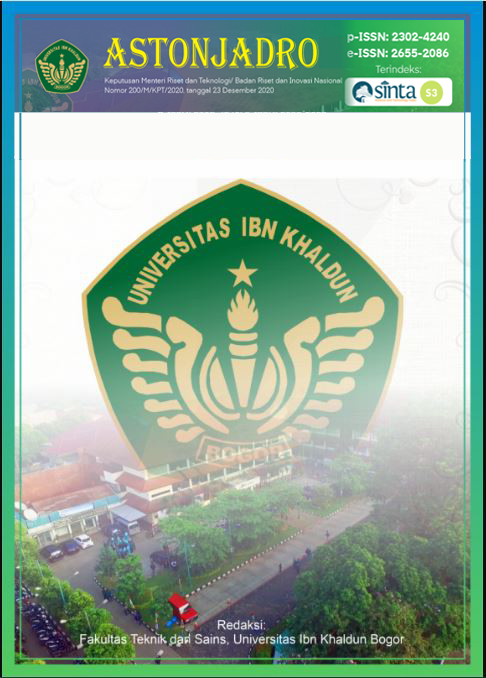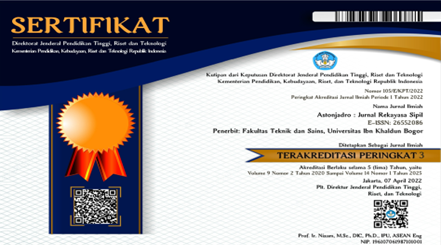Real Response Modification Value of Reinforced Concrete Structures Using the Pushover Method in Horizontal Irranged Buildings
DOI:
https://doi.org/10.32832/astonjadro.v14i1.16264Keywords:
structure building; SPRMK; SPRMB; ETABS.Abstract
The country of Indonesia is prone to earthquakes, because geographically Indonesia is located at the meeting point of four tectonic plates, namely the Asian continental plate, the Australian continental plate, the Indian Ocean plate and the pacificocean plate. An earthquake is a vibration or shock that occurs on the surface of the earth due to the sudden release of energy from within, creating seismic waves. Earthquakes are usually caused by movements of the earth's crust (earth plates). Planning an earthquake-resistant building structure in Indonesia is very important, because most areas in Indonesia are in fairly high earthquake areas, so earthquake regulations, namely SNI 1726-2019, have been issued. Design re-planning or follow-up can be done using the real R value. If in the SRPMK structure the real R value is greater than the design R, then the planner can save reinforcement by re-analyzing the structure using real R. With the results of this research analysis, it can be concluded that the SRPMK structure with horizontal irregularities at the Jakarta location, produces a real modified response (R) value (referring to the ATC-40 limit on the ratio of deviations between floors and the rotational capacity of structural components) which is smaller than the specified maximum value. on SNI. In accordance with the provisions of ATC-40, all structural configurations are included in the Damage Control (DO) category level, which means that the transition between Immediate Occupancy (IO) SP-1 and Life Safety (LF) SP-3, the building is still able to withstand the forces of the earthquake that occurred, with the risk of human loss is very small. Only SRPMB's 8-story medium ground structure is included in the Life Safety (LF) category level SP-3. The real R value obtained in the SRPMK structure varies between 7.218 – 8.515. The results of this analysis are not significantly different from existing provisions, and in soft soil conditions the value is smaller than for the SRPMB structure. Real R less than the provisions is the maximum value that can be used based on this research. The real R value obtained in the SRPMB structure varies between 5.081 – 10.276. The results of this analysis are very different from the existing provisions for both soft and medium soil conditions; and Structural optimization has been carried out in each building configuration, but it was found that the cross-sectional dimensions of the SRPMB columns and beams in soft soil conditions were the largest cross-sectional dimensions compared to the others.
References
ATC-40. 1996. Seismic evaluation and retrofit of concrete building, vol. 1. Redwood City (USA): Applied Technology Council.
Badan Standardisasi Nasional. 2019. SNI 1726-2019. Tata Cara Perencanaan Ketahanan Gempa Untuk Struktur Bangunan Gedung dan Non Gedung. Jakarta, Indonesia.
Badan Standardisasi Nasional. 2019. SNI 2847-2019. Persyaratan Beton Struktural Untuk Bangunan Gedung dan Penjelasan. Jakarta, Indonesia.
Badan Standardisasi Nasional. 2020. SNI 1727-2020. Beban Desain Minimum dan Kriteria Terkait Untuk Bangunan Gedung dan Struktur Lain. Jakarta, Indonesia.
Bullen, K. A., & Bolt, B. A. 1985. An introduction to the theory of seismology. Cambridge University. https://doi.org/10.1119/1.1971106 diakses tanggal 22 Oktober 2021.
CSI (Computers and Structures Incorporated). 2020. ETABS Ultimate, 64-bit, Versi 18.1.1. [Software]. Barkeley, California, Amerika Serikat. www.csiamerica.com
Dewobroto, W. 2005. Evaluasi Kinerja Struktur Baja Tahan Gempa dengan Analisa Pushover. In Civil Engineering National Conference: Sustainability Construction & Structural Engineering Based on Professionalism – Unika Soegijapranata, Semarang(pp.17-18).Juni.Onlineaccess: https://scholar.google.com/citations?view_op=view_citation&hl=en&user=IojiJacAAAAJ&citation_for_view=IojiJacAAAAJ:d1gkVwhDpl0C diakses tanggal 22 Oktober 2021.
FEMA-356. 2000. ‘American Society of Civil Engineers, Prestandard and Commentary for the Seismic Rehabilitation of Building’, ASCE. Rehabilitation, November.
FEMA-440. 2005. ‘Improvement of Nonlinear Static Seismic Analysis Procedures’, Federal Emergency Management Agency, Washington DC.
FEMA-445. 2006. ‘Next-Generation Performance-Based Seismic Design Guidelines’, Federal Emergency Management Agency. Agustus.
Geraldi, R., Christianto, D., & Pranata, H. 2019. Evaluasi Struktur Gedung Dengan Sistem Rangka Beton Pemikul Momen Khusus Berbasis Kinerja. JMTS: Jurnal Mitra Teknik Sipil, 2(2), 115-124. https://doi.org/10.24912/jmts.v2i2.4300 diakses tanggal 23 Oktober 2021.
Hasan, R., Xu, L., & Grierson, D. E. 2002. Pushover analysis for performance-based seismic design. Computers & structures, 80(31), 2483-2493. https://doi.org/10.1016/S0045- 7949(02)00212-2 diakses tanggal 23 Oktober 2021.
Karisoh, P. H., Dapas, S. O., & Pandaleke, R. E. (2018). Perencanaan Struktur Gedung Beton Bertulang dengan Sistem Rangka Pemikul Momen Khusus. Jurnal Sipil Statik, 6(6).Online access: https://ejournal.unsrat.ac.id/index.php/jss/article/viewFile/19859/19456 diakses tanggal 22 Oktober 2021.
Mamesah, H. Y., Wallah, S. E., & Windah, R. S. 2014. Analisis Pushover Pada Bangunan Dengan Soft First Story. Jurnal Sipil Statik, 2(4). https://ejournal.unsrat.ac. id/index.php/jss/article/download/5240/4754 diakses tanggal 18 Oktober 2021.
Mangoda, N. Z., Sultan, M. A., & Imran, I. 2019. Evaluasi Kinerja Gedung Beton Bertulang Dengan Metode Pushover (Studi Kasus Bangunan Gedung di Ternate). Jurnal Sipil Sains, 9(17). http://dx.doi.org/10.33387/sipilsains.v9i17.952 diakses tanggal 08 September 2021.
Marwanto, Ary, Agus Setiya Budi, and Agus Supriyadi. 2014. ‘Evaluasi Kinerja Struktur Gedung 10 Lantai Dengan Analisis Pushover Terhadap Drift dan Displacement Menggunakan Software Etabs’, Jurnal Teknik Sipil, September, 484–91. https://doi.org/10.20961/mateksi.v2i3.37419 diakses tanggal 08 September 2021.
McCaffrey, R. 2009. The tectonic framework of the Sumatran subduction zone. Annual Review of Earth and Planetary Sciences, 37(1), 345-366. https://10.1146/annurev.earth.031208.100212 diakses tanggal 18 September 2021.
Miranda, Eduardo, and Vitelmo V. Bertero. 1994. ‘Evaluation of Strength Reduction Factors for Earthquake-Resistant Design’, Earthquake Spectra, 357–79 https://doi.org/10.1193/1.1585778 diakses tanggal 23 September 2021.
Mondal, Apurba, Siddhartha Ghosh, dan G. R. Reddy. 2013. ‘Performance-Based Evaluation of the Response Reduction Factor for Ductile RC Frames’, Engineering Structures, 56, 1808–19 https://doi.org/10.1016/j.engstruct.2013.07.038 diakses tanggal 23 September 2021.
Oğuz, S. 2005. Evaluation of pushover analysis procedures for frame structure (Master's thesis, Middle East technical university). Online access: http://citeseerx.ist.psu.edu/viewdoc/download?doi=10.1.1.633.8193&rep=rep1&type= pdf
Priyosulistyo, H. 2020. Struktur Beton Bertulang. Gajah Mada University Press: Yogyakarta. Online access: https://ugmpress.ugm.ac.id/userfiles/product/daftar_isi/Perancangan_dan_Analisis_Struktur_Beton_Bertulang_1.pdf
Riantoby, I. K., Budi, A. S., & Purwanto, E. 2014. Evaluasi Kinerja Struktur Pada Gedung Bertingkat dengan Analisis Pushover menggunakan Software Etabs (Studi Kasus: Hotel di Wilayah Karanganyar). Matriks Teknik Sipil, 2(1), 116. Online accsess: http://kin.perpusnas.go.id/DisplayData.aspx?pId=186064&pRegionCode=UN11MAR&pClientId=112 tanggal 02 November 2021.
Structurepoint. 2017. SP Column Versi 6.0. Investigates columns, shear walls, bridge piers in buildings. Skokie, IL, Amerika Serikat. https://www.structurepoint.org/
Sudarmoko. 1996. Perencanaan dan Analisis Kolom Beton Bertulang, Biro Penerbit, Yogyakarta.
Tangahu, B. R., Nur, K. S., & Gani, M. 2019. Analisis Pengaruh Faktor Modifikasi Respon SRPMK Struktur Gedung Beton Bertulang Pada Balok Kategori Desain Seismik D. Jurnal Teknik, 17(1), 57-65. http://dx.doi.org/10.1016/j. engstruct.2014.08.006 diakses tanggal 21 September 2021.
Tarbali, K., & Shakeri, K. 2014. Story shear and torsional moment-based pushover procedure for asymmetric-plan buildings using an adaptive capacity spectrum method. Engineering Structures, 79, 32-44. https://doi.org/10.1016/j.e ngstruct.2014.08.006 diakses tanggal 20 September 2021.
Wardhani, A. S. K., Priyono, P., & Manggala, A. S. 2018. Evaluasi Kapasitas Struktur Gedung Meotel by Dafam Jember Dengan Metode Pushover Analysis. Jurnal Rekayasa Infrastruktur Hexagon, 3(2). https://doi.org/10.32528/hgn.v3i2.2911 diakses tanggal 27 Oktober 2021.
Whittaker, A., Hart, G., & Rojahn, C. 1999. Seismic response modification factors. Journal of Structural Engineering, 125(4), 438-444. https://doi/abs/10.1061/(ASCE)0733- 9445(1999)125:4(438) diakses tanggal 23 September 2021.
Yurizka, Hanan, and Anis Rosyidah. 2020. ‘The Performance of Irregular Building Structures Using Pushover Analysis’, Logic: Jurnal Rancang Bangun dan Teknologi. 20.2. 65–72 https://doi.org/10.31940/logic.v20i2.1456 diakses tanggal 27 Oktober 2021.
Zebua, A. W. 2018. Desain Pelat Gedung Struktur Beton Bertulang di Wilayah Gempa Tinggi. Siklus: Jurnal Teknik Sipil, 4(2), 91-102. https://doi.org/10.31849/ siklus.v4i2.1650 diakses tanggal 21 September 2021.
Damayanti, (2022). Perbandingan Nilai Modifikasi Respons Riil Struktur Momen Khusus Terhadap Struktur Momen Biasa dengan Metoda Pushover. S2 thesis, Universitas Mercu Buana Jakarta. https://repository.mercubuana.ac.id/71142/
Downloads
Published
How to Cite
Issue
Section
License
Copyright (c) 2025 ASTONJADRO

This work is licensed under a Creative Commons Attribution-ShareAlike 4.0 International License.
Paper submitted to ASTONJADRO is the sole property of the Astonjadro Journal. Unless the author withdraws the paper because he does not want to be published in this journal. The publication rights are in the journal Astonjadro.ASTONJADRO
LICENSE
This work is licensed under a Creative Commons Attribution-ShareAlike 4.0 International License.
Based on a work at http://ejournal.uika-bogor.ac.id/index.php/ASTONJADRO













